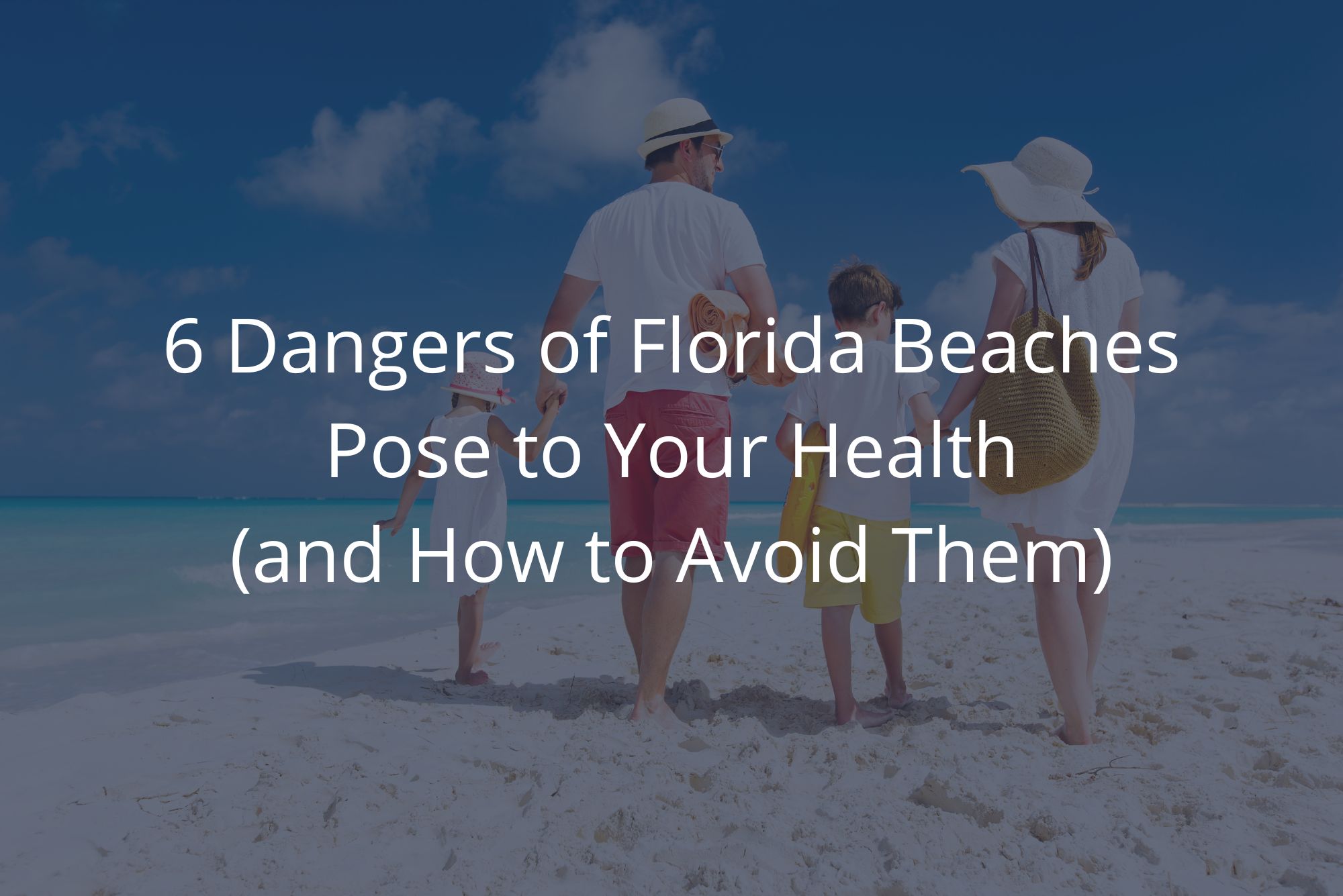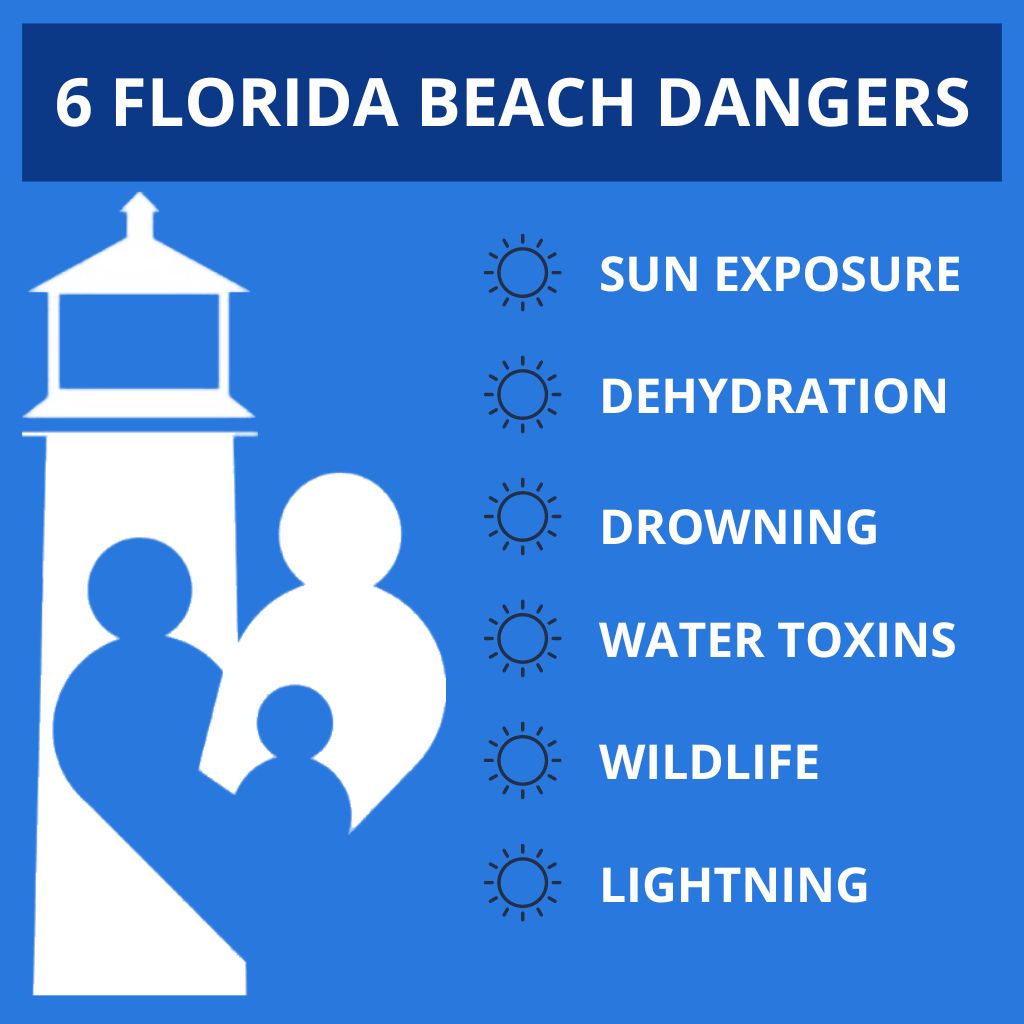
Last year alone, over 120 million tourists visited Florida.
Many of those people visited our beautiful beaches, like Jupiter Beach, DuBois Park, and Carlin Park. And that influx of visitors doesn’t include the number of local residents who spend the day at the beach.
While the beach is a wonderful place to de-stress and enjoy your free time, there are certain beach dangers you should be aware of.
With nearly one billion yearly beach visits in Florida, accidents happen. But many of these accidents are preventable. To facilitate a healthy and safe day of relaxation, below are the most prominent beach dangers to look out for so you can enjoy our beaches without the hassle of a health hazard.
Sun Exposure
One of the most enjoyable aspects of the beach is also one of the most hazardous: the sun. In addition to the hours of fun and pleasure it offers, the sun also presents a short-term risk — sunburn — and a long-term risk — skin cancer.
Sun exposure is a variable risk, because everyone’s skin has a different amount of sun tolerance before damage occurs. However, regardless of your tolerance, it’s always best to apply sunblock of SPF 50 or greater at least 15 minutes before sun exposure and reapply every hour (or more, if your sun tolerance is lower).
Although spray sunblock is more convenient, lotions are the highest quality and provide the best coverage. Make sure you cover vulnerable spots like the tops of your ears and head, the back of your neck, and the tops of your feet and hands. The oft-overlooked areas can take a real beating from the sun.
Dehydration
It’s hard to overstate the importance of being hydrated, because every single function in your body depends upon appropriate levels of water. Thus, when you’re dehydrated, all systems experience dysfunction. This can manifest as dizziness, headaches, cramping, nausea, and weakness.
It’s important to hydrate before you hit the beach. And once you’re there, you’ll need to drink more than usual — at least a pint of water for every hour you spend in the sun.
Important note: Both alcohol and caffeine act as diuretics, meaning they dehydrate you further by increasing your need to urinate. So if possible, avoid alcohol and caffeine while enjoying a sunny beach. If not, be sure to drink an additional pint of water for every jittery java or boozy beverage.
Drowning
Like the sun, the water is both a main attraction and a top hazard of beaches. It’s important to be aware of the realities of Florida’s waters and your ability to stay safely afloat in them.
Again, stay hydrated to avoid cramping and fatigue while swimming, and take care not to swim farther from shore than you can reasonably swim back if you become fatigued. It’s also best to swim with at least one other person, so one of you can call for help if the other gets into trouble.
It’s helpful to educate yourself about water dangers like rip currents, more commonly known as riptides. The National Weather Service has an excellent page dedicated to showing people how to identify and handle rip currents, which are essentially powerful rivers of ocean water that occur anywhere waves are found, and which can carry even the strongest swimmers out to sea.
Despite the dangers, the United States Lifesaving Association calculates the risk of drowning at a beach with lifeguards on duty as one in 18 million. Ocean lifeguards know what they’re doing, and I urge you to always swim with a lifeguard present.
Also, pay special attention to beach warning flags and signs, which can inform you of specific beach dangers present at that particular time.
Water Toxins
Water toxins are a beach concern you may not have come across before. However, even our Florida beaches can experience a buildup of dangerous toxins in the water.
So-called “red tides,” for example, involve a bloom of algae that can cause skin and respiratory irritation, the latter especially in people with asthma. Bacteria such as staph can also build up in the ocean, which increases the risk of skin infections, especially in the presence of cuts and abrasions.
Ocean lifeguards are a great source of information about the day’s conditions, so ask them for the status before you go barreling into the water. You can also check online resources like red tide maps. If there’s a known toxin in the water, don’t get in.
One final note about the water at the beach — there’s a long-enduring myth that the ocean is good for cuts. It isn’t. If you have a cut, don’t go in the water.
Wildlife
The ocean is home to living creatures, and if you’re in their house, you may come into contact with them. This can range from the mildly unpleasant (What just touched my foot?) to severe injury or even death.
One of the most feared wildlife encounters — a shark attack — is also one of the rarest. The Florida Museum of Natural History’s International Shark Attack File (ISAF) investigates and reports on “shark-human interactions.” Their 2021 report confirms 73 unprovoked cases worldwide, nine of which were fatal.
That said, Florida’s beaches have a higher occurrence of shark bites than most places. Of the 47 confirmed bites in the U.S. last year, 28 occurred in Florida, though none were fatal. For perspective, the next highest concentration of shark-human interactions was in Hawaii, which had six shark bites in 2021.
More common than shark bites is the risk of painful stings from jellyfish or stingrays. Manta rays are harmless to humans — their tails don’t have a barb or stinger at the end — and stingrays in general are naturally docile bottom-dwellers. However, they will sting in self-defense if stepped on.
If you’re unlucky enough to be stung by a jellyfish or stingray, the experience is painful, but usually non-threatening. Except in cases of severe allergic reaction, recovery is generally uncomplicated (if uncomfortable).
You can reduce your risk of unwanted and unintentional encounters with ocean wildlife by staying out of the water when jellyfish or sharks are present. Avoid stepping on stingrays by shuffling your feet along the sand, warning them of your presence and giving them time to move out away.
It’s also helpful to avoid wearing jewelry or shiny clothing in the water. Rings and watches may look like reflective, scaly prey to predators. Ditch the jewelry so you’re not inadvertently sending the wrong message.
Lightning
As Florida beach dangers go, you’re far more likely to be struck by lightning than killed by a shark. Lightning strikes result in serious injury or death, and, unfortunately, Florida is known as the “lightning capital” of the U.S.
Lightning can strike from quite a distance, and water conducts that electricity even farther — putting swimmers in danger even if the storm isn’t directly overhead. Additionally, lightning often strikes the tallest object in an area — which on a flat, open beach, could be you.
At the beach, the CDC recommends staying at least 100 yards away from shore when a thunderstorm is rolling through. If you see dark clouds and/or hear thunder, get out of the ocean.
Know the Dangers to Stay Safe at the Beach
Floridians and visitors alike love our beaches for good reason. The sun, the water, and the wildlife all contribute to a satisfying and enjoyable day. But those beach pleasures can become beach dangers without proper knowledge and preparation.
Just a bit of awareness and forethought will help you avoid the risks and bask in the benefits of a day at one of Florida’s beaches.

Dr. David Rosenberg
Dr. Rosenberg is a board-certified Family Physician. He received his medical degree from the University of Miami in 1988 and completed his residency in Family Medicine at The Washington Hospital in Washington, Pennsylvania in 1991. After practicing Emergency Medicine at Palm Beach Gardens Medical Center for two years, he started private practice in Jupiter, in 1993. He is an avid baseball fan and Beatles fanatic, since he was 8 years old. He has been married to his wife, Mary, since 1985 and has three grown children.
David completed additional studies at Mercer University, Macon, Georgia and obtained a BS in Chemistry in 1983.
“My interests include tennis, snow skiing, Pilates and self-development.”

